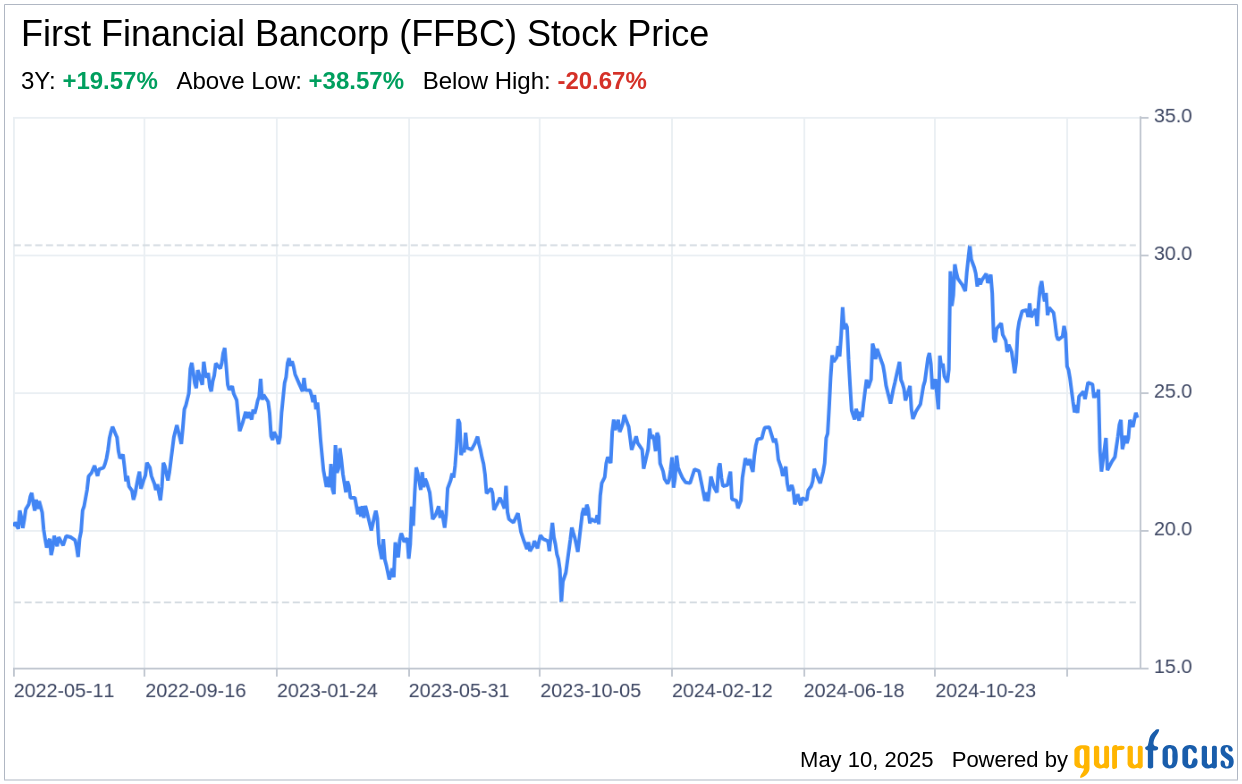On May 9, 2025, First Financial Bancorp (FFBC, Financial), a regional bank holding company, filed its 10-Q report with the SEC, offering a glimpse into its financial performance and strategic positioning. The company reported a slight increase in net income for the first quarter of 2025, with earnings per share holding steady at $0.54. Interest income from loans and leases showed a marginal decline, while investment securities interest and noninterest income streams, such as wealth management fees and leasing business income, exhibited growth. Notably, FFBC's comprehensive income saw a significant boost, largely due to unrealized gains on debt securities. The bank's capital ratios remained robust, indicating a strong balance sheet and the capacity to support future growth initiatives.

Strengths
Financial Performance and Diversification: FFBC's financial performance remains a cornerstone of its strength. The bank's net income saw a modest year-over-year increase from $50,689 thousand to $51,293 thousand in the first quarter of 2025. This stability in earnings is supported by a diversified revenue stream, with noninterest income contributing significantly through wealth management fees, bankcard income, and leasing business income. The growth in these areas, particularly the 26.9% increase in leasing business income, underscores FFBC's ability to leverage its various lines of business to maintain profitability.
Capital Adequacy and Comprehensive Income: FFBC's capital ratios are a testament to its financial resilience. The bank's capital adequacy, with a total capital ratio of 14.90% as of March 31, 2025, positions it well above the regulatory requirements for being considered "well-capitalized." Additionally, the bank's comprehensive income nearly doubled from the same period last year, buoyed by a substantial unrealized gain on debt securities. This improvement in comprehensive income reflects FFBC's adept management of its investment portfolio and its ability to benefit from favorable market conditions.
Weaknesses
Interest Income Pressure: Despite FFBC's overall solid financial performance, there is a notable decline in interest income from loans and leases, which decreased by approximately 2.3% compared to the same quarter in the previous year. This suggests a potential softening in the bank's core lending activities, which could be attributed to competitive pressures or shifts in market demand. As interest income is a critical component of a bank's revenue, this decline could impact FFBC's net interest margin and profitability if it continues.
Operational Costs: Noninterest expenses have risen by 4.7%, with notable increases in salaries and employee benefits, and a significant jump in leasing business expenses. While some of this growth can be associated with the expansion of business activities, it also indicates that FFBC is facing higher operational costs. Managing these expenses will be crucial for maintaining profit margins, especially in a competitive banking environment where cost efficiency can be a differentiator.
Opportunities
Market Expansion and Acquisitions: FFBC's recent acquisition of Agile Premium Finance demonstrates its strategic intent to expand its specialty finance offerings. The acquisition, which has been integrated successfully, presents opportunities for FFBC to diversify its loan portfolio and tap into new revenue streams. Additionally, the bank's strong capital position enables it to consider further strategic acquisitions that align with its growth objectives and enhance its market presence.
Technological Advancements: The banking industry is increasingly influenced by technological innovation. FFBC has the opportunity to invest in digital banking platforms and fintech collaborations to enhance customer experience and operational efficiency. By adopting new technologies, the bank can attract tech-savvy customers, streamline processes, and stay competitive in a rapidly evolving financial landscape.
Threats
Interest Rate Fluctuations: FFBC, like all financial institutions, is susceptible to interest rate risk. Changes in interest rates can affect the bank's net interest income and the market value of its assets. With the economic landscape continually shifting, FFBC must navigate these uncertainties carefully to mitigate potential adverse effects on its earnings and capital position.
Regulatory and Compliance Risks: The banking sector is subject to stringent regulatory oversight. Changes in banking regulations, such as those related to capital requirements or consumer protection, could impose additional compliance costs or limit FFBC's business activities. The bank must remain vigilant and adaptable to ensure compliance with evolving regulatory demands while pursuing its strategic goals.
In conclusion, First Financial Bancorp (FFBC, Financial) exhibits a strong financial foundation with a diversified revenue base and robust capital adequacy, positioning it well for future growth. However, the bank must address the challenges of declining interest income and rising operational costs to maintain its competitive edge. Opportunities for expansion through acquisitions and technological innovation present promising avenues for growth, while interest rate fluctuations and regulatory changes pose ongoing threats. FFBC's ability to capitalize on its strengths and opportunities while effectively managing its weaknesses and threats will be critical in navigating the dynamic banking landscape.
This article, generated by GuruFocus, is designed to provide general insights and is not tailored financial advice. Our commentary is rooted in historical data and analyst projections, utilizing an impartial methodology, and is not intended to serve as specific investment guidance. It does not formulate a recommendation to purchase or divest any stock and does not consider individual investment objectives or financial circumstances. Our objective is to deliver long-term, fundamental data-driven analysis. Be aware that our analysis might not incorporate the most recent, price-sensitive company announcements or qualitative information. GuruFocus holds no position in the stocks mentioned herein.
